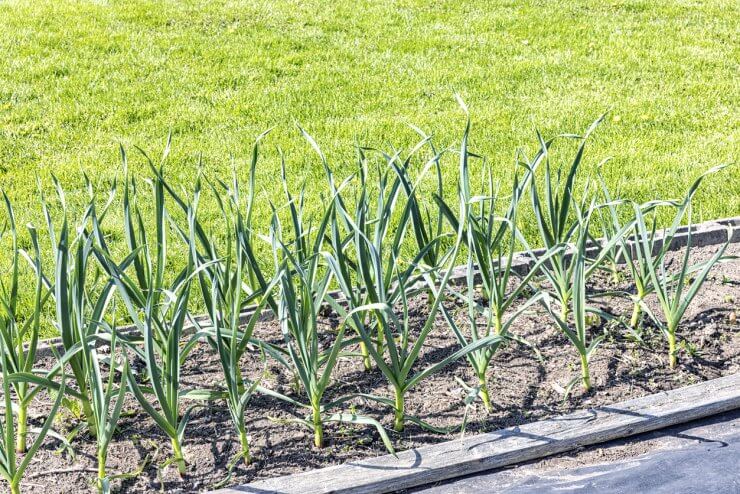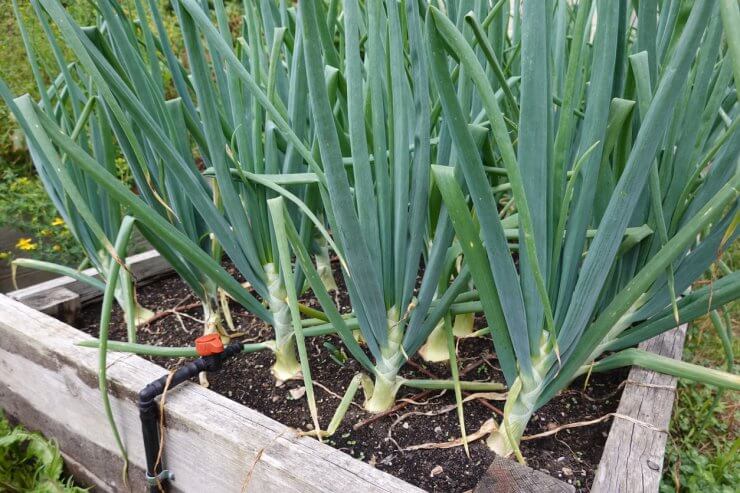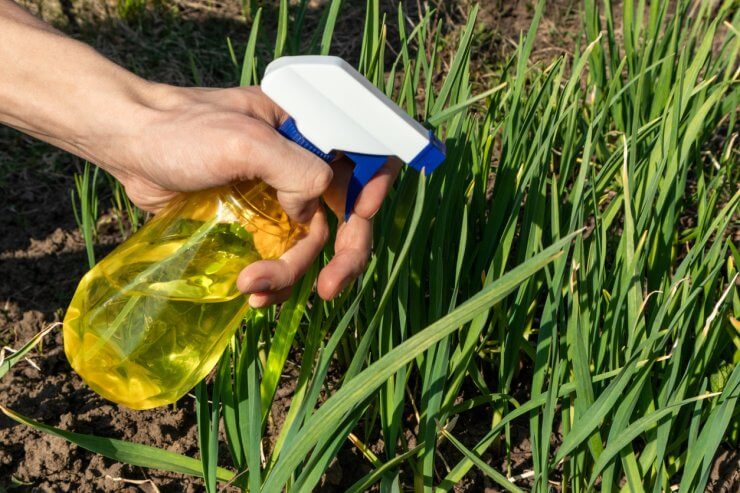
Rows of Garlic Plant Stalks Growing in a Home Vegetable Garden
Garlic has always carried an air of mystery. It wards off vampires in folklore, promises strength in ancient medicine, and flavors nearly every cuisine on earth. But in the garden, garlic has another reputation: protector. Tucked into raised beds or planted in tidy borders, it’s said to keep away everything from aphids to rabbits. It’s a bold claim, and one that begs for a closer look. Is garlic truly the bodyguard your tomatoes and roses need, or is this another garden legend that lingers as long as the smell on your hands?
The chemistry of defense
Garlic’s strong scent isn’t just an accident. It’s a carefully evolved defense mechanism. When you slice into a clove, you unleash a chemical reaction between the compounds alliin and the enzyme alliinase. The result is allicin, a sulfur-based compound that is both pungent and potent. To us, it smells delicious – the start of a meal. To microbes, fungi, and small herbivores, it’s a warning sign.
This chemistry explains why garlic has been used medicinally for thousands of years. Allicin is antimicrobial, antifungal, and even somewhat antiviral. In the soil, the release of these compounds can deter certain harmful fungi and bacteria. In the air, the smell is strong enough to catch the attention (and noses) of insects and mammals alike.
But here’s the catch: unless you’re chopping garlic cloves and scattering them around, most of that potent allicin stays locked inside. A growing garlic plant has its own subtle fragrance, but it’s not constantly emitting high doses of pest-repelling chemicals. That’s why gardeners often rely on garlic-based sprays. When cloves are crushed and steeped in water or oil, then sprayed on plant leaves, the concentration of allicin increases dramatically. Suddenly, a tomato leaf smells like a garlic clove – and many pests want nothing to do with it.

Cultivation of onion in the ecological urban garden. Onions growing in raised beds. Growing onions in the field. Backyard
Myth, memory, and experiments
Gardeners have long passed down stories about garlic’s protective powers. Your neighbor might swear her roses never see aphids thanks to a ring of garlic around the bed. Another gardener insists his carrots grow cleaner when planted with garlic. Folklore aside, what does the science say?
Controlled studies give mixed results. Some research suggests garlic extracts and sprays do reduce infestations of soft-bodied insects such as aphids, whiteflies, and certain caterpillars. The compounds irritate pests’ delicate exteriors and interfere with their feeding. But simply planting garlic nearby doesn’t seem to create an invisible shield. Bugs don’t turn around at the smell of a growing garlic plant.
And yet, the stories persist – partly because garlic’s reputation has always been larger than life. Throughout history, garlic has been considered protective: warding off illness, evil spirits, or misfortune. In medieval Europe, garlic was rubbed on doorways or carried into fields to keep away not just pests but bad luck. Farmers used what they had, and garlic was abundant, versatile, and easy to believe in. Over time, these memories became part of gardening tradition.
There is also the possibility that garlic works indirectly. A patch of garlic, with its upright stalks and thick leaves, can act as a mild trap crop, drawing some pests away simply because it’s another texture and scent in the garden. Or, perhaps more likely, the gardeners who plant garlic also tend to be more observant – and pests never get the upper hand because those gardeners are paying attention.
Mammals, myths, and munching
Insects aren’t the only targets of garlic’s supposed protective powers. Some gardeners claim garlic deters rabbits, deer, and even groundhogs. There’s some truth here: mammals with sensitive noses dislike strong odors, and garlic sprays can be effective when applied to vulnerable crops. A rabbit is less likely to nibble on your lettuce if it reeks of garlic oil.
But again, garlic itself is not a foolproof barrier. A hungry deer in midsummer will eat despite the smell. Rabbits that are used to garlic in their environment may not care at all. The key is freshness: sprays must be reapplied often, especially after rain, to keep their potency. Garlic works best as one tool in a larger strategy of fencing, netting, and attentive gardening.
How to put garlic to the test
So, is garlic a guardian? The answer is both yes and no. Yes, garlic has proven pest-repelling qualities when applied in sprays or oils. Yes, its strong scent can discourage mammals, at least temporarily. But no, a few cloves planted in the soil won’t create a magical force field.
The real joy comes in experimenting. You can make your own garlic spray by crushing cloves, mixing them with water and a touch of soap, and applying the liquid to leaves prone to attack. Some gardeners add hot pepper or neem oil for extra punch. Others plant garlic at the edges of beds to create a visual border and track whether pest pressure seems lighter there than in untreated areas.
A gardener with a curious mind can treat garlic like a homegrown science experiment: set up two rows of beans, spray one with garlic solution, and leave the other untreated. Keep notes, compare results, and see if the folklore holds true in your soil.
And here’s the best part: even if the sprays fail or the rabbits remain undeterred, you still win. You’ve planted garlic, one of the most rewarding crops in the garden. You’ll harvest bulbs in summer, snip scapes in spring, and enjoy cloves all winter. Few other pest-control methods come with such a delicious consolation prize.

Gardener hand spray from plastic yellow bottle sprinkler on green garlic grass. Spring sunny garden working on fresh air.
Quick tips for using garlic as a pest deterrent
- Garlic spray basics: Crush 2–3 cloves, steep in water overnight, strain, and spray on leaves. Add a drop of dish soap to help it stick.
- Reapply often: Rain and sun reduce potency; spray every few days during infestations.
- Mix with care: Avoid spraying garlic solutions on hot, sunny days, as concentrated sprays can burn leaves.
- Companion planting: Try borders of garlic around roses, lettuce, or brassicas, but don’t rely solely on planting for pest control.
- Watch for mammals: Garlic sprays can help deter rabbits and deer, but results vary – fencing may still be necessary.
Garlic may not banish every pest, but its role as both crop and possible protector makes it endlessly fascinating. It sits at the crossroads of science and folklore, utility and mystery. Even if you discover that its powers are more modest than magical, you’ll still have something to show for your efforts: rows of papery bulbs, tangy scapes, and the satisfaction of knowing you’ve carried on a tradition as old as gardening itself.
Want to learn more about growing garlic? With our Garlic Gardening Guide, you’ll have everything you need to know about growing and enjoying this staple—from the history and health benefits of this ancient herb, to detailed and specific garlic gardening advice, and easy-to-make and delicious recipes that will allow you to spice up any dish!


 Previous
Previous

